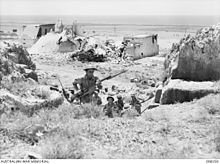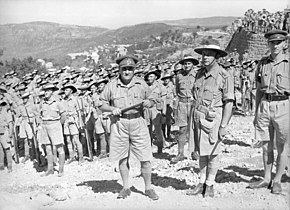Murray Moten
[3] Moten was sent on leave – apparently suffering from flat feet[1] – but was discharged as medically unfit due to heart problems and poor physique in January 1918.
[10] On 26 April, Moten joined the all-volunteer Second Australian Imperial Force (Second AIF), and was appointed as the commanding officer of the 2/27th Battalion at the substantive rank of lieutenant colonel.
[11][16] Sailing via British India, the 2/27th briefly made camp at Deolali outside of Bombay for a week before embarking on the Takliwa for the rest of the voyage to the Middle East.
[11][18] After completing its training, the unit moved with the rest of the 7th Division to the Western Desert fortresses at Mersa Matruh and nearby Maaten Bagush in April 1941.
[20] The main body of the unit crossed the Suez Canal at Kantara on 26 May, and reached its assembly area at Kfar Yehezkel in northern Palestine two days later.
[22] The invasion began in the early hours of 8 June but Stevens decided not to push Moten's fully-motorised column through the 2/14th Battalion, but instead kept that unit moving forward to establish if the French had cratered the road or demolished bridges that would stop the 2/27th from advancing.
The cavalry pushed on through sporadic resistance past Kafr Badda, but both infantry battalions met opposition among the hills east of the road, and suffered casualties.
[26] At this stage the advance was held up by the French north of Khan Saada, where they had established defensive positions in the Wadi Zaharani, which dominated the intersection with the road running east towards Merdjayoun.
All members of the battalion were very weary after five days of constant advancing and fighting, and when the trailing companies reached the lead ones before dawn on 14 June, they relieved them so they could prepare for the attack.
[28] Initially successful French counter-attacks on the inland column around Merdjayoun resulted in Stevens being ordered on 17 June to hold any further advance and send the 2/14th Battalion to reinforce Australian troops at Jezzine.
[29] Despite the halt until the situation at Merdjayoun was resolved, the 21st Brigade pushed forward strong cavalry patrols and on 19 June the 2/16th captured the village of Jadra north of the Wadi Zeini.
On 21 June Moten sent patrols to Sebline and Kafr Maya, and for the next few days the battalion picqueted the lateral roads and tracks further south protecting the eastern flank of the coastal column.
On 25 June, Stevens sent the 2/27th and 2/16th forward to the El Haram ridgeline, and ordered Moten, who was to hold the right-hand position on the ridge, to send patrols towards Er Rezaniy.
[33] The most advanced company of the 2/27th reached the eastern outskirts of Damour and sent two platoons into the town where they had several sharp exchanges of fire with French troops and captured more than their own number.
[35] It soon became apparent that the French had withdrawn a considerable distance on all fronts of the campaign, and Stevens was ordered secure the villages of Abey and Kafra Matta overlooking Damour.
[44] The citation for the DSO read:[45]To effect the capture of Saida [Sidon] in the face of a well organized and determined defence which blocked any progress along the Coast Road it was necessary to turn the position from the right flank.
This officer also showed excellent leadership skills, gallantry and devotion to duty at Battle of Damour.In early January 1942, it was agreed between the British and Australian governments that the 6th Division would be withdrawn from Syria and move to the Far East in response to the entry of Japan into the war.
During the move, Moten visited Melbourne and was permitted to read a confidential report on the fighting on the Kokoda Trail in New Guinea written by the war correspondent Chester Wilmot.
[57] Moten administered command of the 11th Division from 29 December until he flew to Wau in the New Guinea on 9 January 1943 to conduct a reconnaissance for a planned brigade deployment to the area.
By the time Moten arrived in Wau, the core of the force consisted of the 2/5th and 2/7th Independent Companies, irregular units trained for long-range patrol and surveillance.
[59][60] Moten returned to Port Moresby on 14 January and the following day he received written orders that he was to take over defences at Wau and command of Kanga Force.
He decided that, despite a lack of reserves in Wau due to the slow buildup, he would attack the advancing Japanese from the forward positions of the 2/6th on the Black Cat Track.
Moten's positions held, and by mid-morning he considered that with the arrival of two guns of the 2/1st Field Regiment on aircraft earlier that morning he could take the initiative using a company of the 2/7th to forestall a Japanese flanking manoeuvre to the south of Leahy's Farm, leaving the remainder of the force to protect the airfield.
This move, supported by strafing by Royal Australian Air Force Bristol Beaufighters, caused significant enemy casualties and stopped the Japanese in their tracks.
By nightfall on 3 February, the Wau defences were holding well, another company of the 2/7th had been pushed forward south of Leahy's Farm to block further Japanese advances, and their assaults were clearly weakening.
[65] Moten then committed the 2/5th Battalion to offensive action, and in hard fighting up to 9 February they cleared the area west of the Bulolo River, killing hundreds of Japanese and putting the rest to flight.
[77] On 23 April, Kanga Force was dissolved and the headquarters of Major General Stanley Savige's 3rd Division opened at Bulolo, taking command of Moten's brigade.
[78] An abortive company attack on a Japanese-held feature called "The Pimple" by the 2/7th Battalion on 24 and 25 April showed that extensive reconnaissance, improved communication and pinpoint accuracy from supporting aircraft and artillery were required for such limited offensive actions to be successful.
[83] On 12 May, Moten revised his plan based on his expectation that the Japanese would remain on a defensive footing around Salamaua and Mubo, and decided he would continue to use only one battalion forward, with a company securing the coast south from the Bitoli River to Nassau Bay through raiding.
[86] The 17th Brigade repulsed Japanese assaults at Mubo and Lababia Ridge and following the capture of Komiatum and Mount Tambu in August, Moten was appointed Commander of the Order of the British Empire and again mentioned in despatches.



